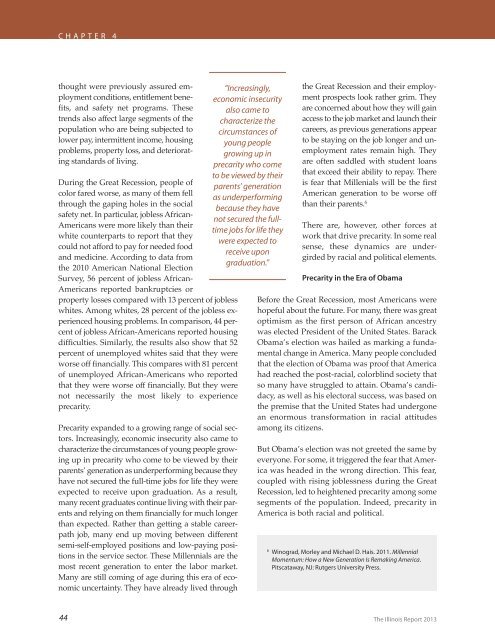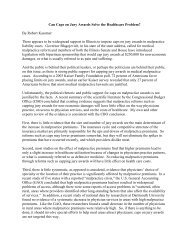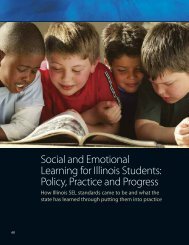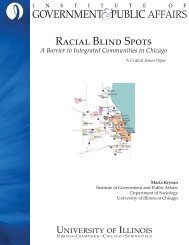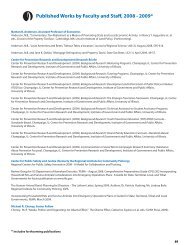The Illinois Report 2013 - Institute of Government & Public Affairs ...
The Illinois Report 2013 - Institute of Government & Public Affairs ...
The Illinois Report 2013 - Institute of Government & Public Affairs ...
You also want an ePaper? Increase the reach of your titles
YUMPU automatically turns print PDFs into web optimized ePapers that Google loves.
C H A P T E R 4<br />
thought were previously assured employment<br />
conditions, entitlement benefits,<br />
and safety net programs. <strong>The</strong>se<br />
trends also affect large segments <strong>of</strong> the<br />
population who are being subjected to<br />
lower pay, intermittent income, housing<br />
problems, property loss, and deteriorating<br />
standards <strong>of</strong> living.<br />
During the Great Recession, people <strong>of</strong><br />
color fared worse, as many <strong>of</strong> them fell<br />
through the gaping holes in the social<br />
safety net. In particular, jobless African-<br />
Americans were more likely than their<br />
white counterparts to report that they<br />
could not afford to pay for needed food<br />
and medicine. According to data from<br />
the 2010 American National Election<br />
Survey, 56 percent <strong>of</strong> jobless African-<br />
Americans reported bankruptcies or<br />
property losses compared with 13 percent <strong>of</strong> jobless<br />
whites. Among whites, 28 percent <strong>of</strong> the jobless experienced<br />
housing problems. In comparison, 44 percent<br />
<strong>of</strong> jobless African-Americans reported housing<br />
difficulties. Similarly, the results also show that 52<br />
percent <strong>of</strong> unemployed whites said that they were<br />
worse <strong>of</strong>f financially. This compares with 81 percent<br />
<strong>of</strong> unemployed African-Americans who reported<br />
that they were worse <strong>of</strong>f financially. But they were<br />
not necessarily the most likely to experience<br />
precarity.<br />
Precarity expanded to a growing range <strong>of</strong> social sectors.<br />
Increasingly, economic insecurity also came to<br />
characterize the circumstances <strong>of</strong> young people growing<br />
up in precarity who come to be viewed by their<br />
parents’ generation as underperforming because they<br />
have not secured the full-time jobs for life they were<br />
expected to receive upon graduation. As a result,<br />
many recent graduates continue living with their parents<br />
and relying on them financially for much longer<br />
than expected. Rather than getting a stable careerpath<br />
job, many end up moving between different<br />
semi-self-employed positions and low-paying positions<br />
in the service sector. <strong>The</strong>se Millennials are the<br />
most recent generation to enter the labor market.<br />
Many are still coming <strong>of</strong> age during this era <strong>of</strong> economic<br />
uncertainty. <strong>The</strong>y have already lived through<br />
“Increasingly,<br />
economic insecurity<br />
also came to<br />
characterize the<br />
circumstances <strong>of</strong><br />
young people<br />
growing up in<br />
precarity who come<br />
to be viewed by their<br />
parents’ generation<br />
as underperforming<br />
because they have<br />
not secured the fulltime<br />
jobs for life they<br />
were expected to<br />
receive upon<br />
graduation.”<br />
the Great Recession and their employment<br />
prospects look rather grim. <strong>The</strong>y<br />
are concerned about how they will gain<br />
access to the job market and launch their<br />
careers, as previous generations appear<br />
to be staying on the job longer and unemployment<br />
rates remain high. <strong>The</strong>y<br />
are <strong>of</strong>ten saddled with student loans<br />
that exceed their ability to repay. <strong>The</strong>re<br />
is fear that Millenials will be the first<br />
American generation to be worse <strong>of</strong>f<br />
than their parents. 6<br />
<strong>The</strong>re are, however, other forces at<br />
work that drive precarity. In some real<br />
sense, these dynamics are undergirded<br />
by racial and political elements.<br />
Precarity in the Era <strong>of</strong> Obama<br />
Before the Great Recession, most Americans were<br />
hopeful about the future. For many, there was great<br />
optimism as the first person <strong>of</strong> African ancestry<br />
was elected President <strong>of</strong> the United States. Barack<br />
Obama’s election was hailed as marking a fundamental<br />
change in America. Many people concluded<br />
that the election <strong>of</strong> Obama was pro<strong>of</strong> that America<br />
had reached the post-racial, colorblind society that<br />
so many have struggled to attain. Obama’s candidacy,<br />
as well as his electoral success, was based on<br />
the premise that the United States had undergone<br />
an enormous transformation in racial attitudes<br />
among its citizens.<br />
But Obama’s election was not greeted the same by<br />
everyone. For some, it triggered the fear that America<br />
was headed in the wrong direction. This fear,<br />
coupled with rising joblessness during the Great<br />
Recession, led to heightened precarity among some<br />
segments <strong>of</strong> the population. Indeed, precarity in<br />
America is both racial and political.<br />
6<br />
Winograd, Morley and Michael D. Hais. 2011. Millennial<br />
Momentum: How a New Generation Is Remaking America.<br />
Pitscataway, NJ: Rutgers University Press.<br />
44<br />
<strong>The</strong> <strong>Illinois</strong> <strong>Report</strong> <strong>2013</strong>


